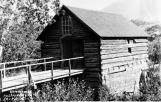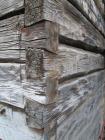1
Barrington Price was born in England in 1841. As a "Remittance Man", he came to the Similkameen Valley in 1872. He leased the Hudson Bay Post and ranch which had been vacated the year before. The Post was located on the Keremeos Creek where the Dewdney Trail crossed. Price acquired land (1,500 acres) and ranched with a partner, Henry Nicholson.3
By 1876, Price realized a business venture: Flour, a staple of the prospector and cattleman's diets, had to be brought in from Oroville in Washington State, some 120 miles away. Whole wheat flour has no natural preservatives so much of the flour from Oroville arrived rancid. Price would have the local First Nations grow wheat on the bottom land near the Similkameen River where irrigation wasn't required; then build a grist mill to produce local flour.Price began construction of a log mill in 1876 and had it operating with a Barford & Perkins' Improved Corn Grinder in August 1877. He had a store built also, of log construction.
4
Price was a successful businessman and expanded the mill in 1881 with a James Jones New Process grinder to meet increasing demand. Price was however, as rumour has it, not a successful gambler. By 1884 he leased the Mill to John Haning Coulthard to cover gambling debits and officially sold it to him by 1903.Coulhart operated the Mill, adding a Waterous grinder from Brantford Ontario likely in the early 1890's. A problem arose in the mid 1890's in that Price had not obtained the water rights to Keremeos Creek. The ranchers did and by 1895 the Mill was shut down for lack of water supply. Possibly, the 1893 rail connection to the North Okanogan had an influence on the Mill's operation as well.
Coulhart sold the property to W H Armstrong in 1905 who ranched the land.
5
Miss Armstrong on the Mill bridge18 May 1910
Grist Mill at Keremeos Creek, Keremeos British Columbia, Canada
 Credits:
Credits:Rev. Cameron
6
Log Store Convert to the Whitehouse20th Century, Circa 1912
Whitehouse at Keremeos Creek, Keremeos British Columbia, Canada
 Credits:
Credits:Grist Mill Collection
7
The V,V&E railway was built beside the Similkameen River in 1907, causing the Village of Keremeos to relocate. This isolated the Mill and aided in its preservation. For the next seventy odd years, the Mill was used as a barn, a chicken coup and then Weldon Munden's artist's studio.8
Grist Mill looking south east1926-1927
Grist Mill at Keremeos Creek, Keremeos British Columbia, Canada
 Credits:
Credits:W H Ribelin
9
The Mill in the winter of 197520th Century, circa 1975
Grist Mill at Keremeos Creek, Keremeos British Columbia, Canada
 Credits:
Credits:Brenda Walters nee Smith
10
The South Similkameen Museum members were instrumental in the preserving of the Mill. They encouraged the Province of British Columbia to designate it as a heritage site in 1977.11
Dedication of the Mill as a Province heritage site20th Centurry, circa 1977
Grist Mill at Keremeos Creek, Keremeos British Columbia, Canada
 Credits:
Credits:unknown
12
The Province of British Columbia purchased the Mill and Whitehouse in 1979. The buildings were restored; a number of logs had to be replaced on the bottom of the Mill (note light coloured).13
The restored Grist Mill1982-1983
Grist Mill at Keremeos Creek, Keremeos British Columbia, Canada
 Credits:
Credits:Unknown
14
Detail of dovetail joints5 October 2012
Grist Mill at Keremeos Creek, Keremeos British Columbia, Canada
 Credits:
Credits:Jim Millar
